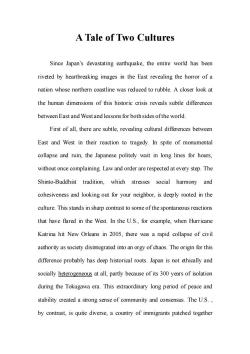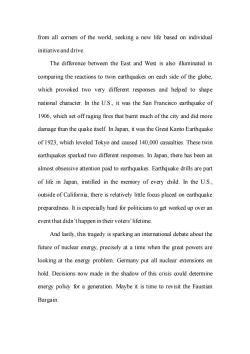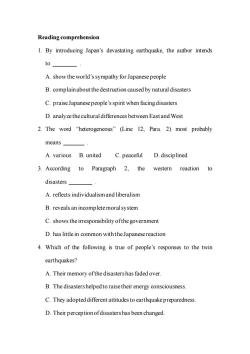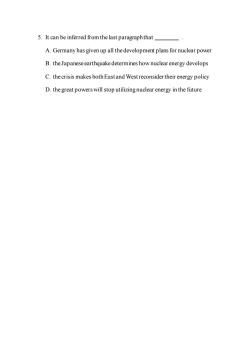私立华联学院:《英文报刊阅读》课程教学资源(练习题,十套)A Tale of Two Cultrues文化报道_A Tale of Two Cultures

A Tale of Two Cultures Since Japan's devastating earthquake,the entire world has been riveted by heartbreaking images in the East revealing the horror of a nation whose northern coastline was reduced to rubble.A closer look at the human dimensions of this historic crisis reveals subtle differences between East and West and lessons for bothsides ofthe world First of all,there are subtle,revealing cultural differences between East and West in their reaction to tragedy.In spite of monumental collapse and ruin,the Japanese politely wait in long lines for hours, without once complaining.Law and order are respected at every step.The Shinto-Buddhist tradition,which stresses social harmony and cohesiveness and looking out for your neighbor,is deeply rooted in the culture.This stands in sharp contrast to some ofthe spontaneous reactions that have flared in the West.In the U.S.,for example,when Hurricane Katrina hit New Orleans in 2005,there was a rapid collapse of civil authority as society disintegrated into an orgy of chaos.The origin for this difference probably has deep historical roots.Japan is not ethically and socially heterogeneous at all,partly because of its 300 years of isolation during the Tokugawa era.This extraordinary long period of peace and stability created a strong sense of community and consensus.The U.S., by contrast,is quite diverse,a country of immigrants patched together
A Tale of Two Cultures Since Japan’s devastating earthquake, the entire world has been riveted by heartbreaking images in the East revealing the horror of a nation whose northern coastline was reduced to rubble. A closer look at the human dimensions of this historic crisis reveals subtle differences between East and West and lessons for both sides of the world. First of all, there are subtle, revealing cultural differences between East and West in their reaction to tragedy. In spite of monumental collapse and ruin, the Japanese politely wait in long lines for hours, without once complaining. Law and order are respected at every step. The Shinto-Buddhist tradition, which stresses social harmony and cohesiveness and looking out for your neighbor, is deeply rooted in the culture. This stands in sharp contrast to some of the spontaneous reactions that have flared in the West. In the U.S., for example, when Hurricane Katrina hit New Orleans in 2005, there was a rapid collapse of civil authority as society disintegrated into an orgy of chaos. The origin for this difference probably has deep historical roots. Japan is not ethically and socially heterogeneous at all, partly because of its 300 years of isolation during the Tokugawa era. This extraordinary long period of peace and stability created a strong sense of community and consensus. The U.S. , by contrast, is quite diverse, a country of immigrants patched together

from all corners of the world,seeking a new life based on individual initiative and drive. The difference between the East and West is also illuminated in comparing the reactions to twin earthquakes on each side of the globe, which provoked two very different responses and helped to shape national character.In the U.S.,it was the San Francisco earthquake of 1906,which set off raging fires that burnt much of the city and did more damage than the quake itself.In Japan,it was the Great Kanto Earthquake of 1923,which leveled Tokyo and caused 140,000 casualties.These twin earthquakes sparked two different responses.In Japan,there has been an almost obsessive attention paid to earthquakes.Earthquake drills are part of life in Japan,instilled in the memory of every child.In the U.S., outside of California,there is relatively little focus placed on earthquake preparedness.It is especially hard for politicians to get worked up over an event that didn'thappen in their voters'lifetime. And lastly,this tragedy is sparking an international debate about the future of nuclear energy,precisely at a time when the great powers are looking at the energy problem.Germany put all nuclear extensions on hold.Decisions now made in the shadow of this crisis could determine energy policy for a generation.Maybe it is time to revisit the Faustian Bargain
from all corners of the world, seeking a new life based on individual initiative and drive. The difference between the East and West is also illuminated in comparing the reactions to twin earthquakes on each side of the globe, which provoked two very different responses and helped to shape national character. In the U.S., it was the San Francisco earthquake of 1906, which set off raging fires that burnt much of the city and did more damage than the quake itself. In Japan, it was the Great Kanto Earthquake of 1923, which leveled Tokyo and caused 140,000 casualties. These twin earthquakes sparked two different responses. In Japan, there has been an almost obsessive attention paid to earthquakes. Earthquake drills are part of life in Japan, instilled in the memory of every child. In the U.S., outside of California, there is relatively little focus placed on earthquake preparedness. It is especially hard for politicians to get worked up over an event that didn’t happen in their voters’lifetime. And lastly, this tragedy is sparking an international debate about the future of nuclear energy, precisely at a time when the great powers are looking at the energy problem. Germany put all nuclear extensions on hold. Decisions now made in the shadow of this crisis could determine energy policy for a generation. Maybe it is time to revisit the Faustian Bargain

Reading comprehension 1.By introducing Japan's devastating earthquake,the author intends to A.show the world's sympathy for Japanese people B.complainabout the destruction caused by natural disasters C.praise Japanese people's spirit when facingdisasters D.analyze the cultural differences between East and West 2.The word "heterogeneous"(Line 12,Para.2)most probably means A.various B.united C.peaceful D.disciplined 3.According to Paragraph 2,the western reaction to disasters_ A.reflects individualism and liberalism B.reveals an incomplete moral system C.shows the irresponsibility ofthe government D.has little in common withthe Japanesereaction 4.Which of the following is true of people's responses to the twin earthquakes? A.Their memory ofthe disasters has faded over. B.The disastershelpedto raisetheir energy consciousness. C.They adopted different attitudes to earthquake preparedness. D.Their perceptionofdisasters has been changed
Reading comprehension 1. By introducing Japan’s devastating earthquake, the author intends to . A. show the world’s sympathy for Japanese people B. complain about the destruction caused by natural disasters C. praise Japanese people’s spirit when facing disasters D. analyze the cultural differences between East and West 2. The word “heterogeneous” (Line 12, Para. 2) most probably means . A. various B. united C. peaceful D. disciplined 3. According to Paragraph 2, the western reaction to disasters . A. reflects individualism and liberalism B. reveals an incomplete moral system C. shows the irresponsibility of the government D. has little in common with the Japanese reaction 4. Which of the following is true of people’s responses to the twin earthquakes? A. Their memory of the disasters has faded over. B. The disasters helped to raise their energy consciousness. C. They adopted different attitudes to earthquake preparedness. D. Their perception of disasters has been changed

5.It can be inferred from the last paragraphthat A.Germany has given up all the development plans for nuclear power B.the Japaneseearthquake determines how nuclear energy develops C.thecrisis makes both East and West reconsider their energy policy D.the great powers will stop utilizingnuclear energy in the future
5. It can be inferred from the last paragraph that . A. Germany has given up all the development plans for nuclear power B. the Japanese earthquake determines how nuclear energy develops C. the crisis makes both East and West reconsider their energy policy D. the great powers will stop utilizing nuclear energy in the future
按次数下载不扣除下载券;
注册用户24小时内重复下载只扣除一次;
顺序:VIP每日次数-->可用次数-->下载券;
- 私立华联学院:《英文报刊阅读》课程教学资源(练习题,十套)练习题十套的参考答案.docx
- 私立华联学院:《英文报刊阅读》课程教学资源(试卷)英文报刊阅读考卷A(含答案).doc
- 私立华联学院:《英语精读》课程PPT教学课件(A New English Course)Unit 9 University Days.ppt
- 私立华联学院:《英语精读》课程PPT教学课件(A New English Course)Unit 8 A Friend in Need.ppt
- 私立华联学院:《英语精读》课程PPT教学课件(A New English Course)Unit 7 From Composer to Interpreter to Listener.ppt
- 私立华联学院:《英语精读》课程PPT教学课件(A New English Course)Unit 6 The Pearl.ppt
- 私立华联学院:《英语精读》课程PPT教学课件(A New English Course)Unit 5 Antarctica.ppt
- 私立华联学院:《英语精读》课程PPT教学课件(A New English Course)Unit 4 Network Desinger——-Tim Berners-Lee.ppt
- 私立华联学院:《英语精读》课程PPT教学课件(A New English Course)Unit 3 Writing between the lines.ppt
- 私立华联学院:《英语精读》课程PPT教学课件(A New English Course)Unit 2 Salvation.ppt
- 私立华联学院:《英语精读》课程PPT教学课件(A New English Course)Unit 12 After Twenty Years.ppt
- 私立华联学院:《英语精读》课程PPT教学课件(A New English Course)Unit 11 Neat People vs. Sloppy People.ppt
- 私立华联学院:《英语精读》课程PPT教学课件(A New English Course)Unit 10 Abducting the Cloning Debate.ppt
- 私立华联学院:《英语精读》课程PPT教学课件(A New English Course)Unit 1 Resolutions.ppt
- 私立华联学院:《英语精读》课程教学资源(试卷习题)新大学英语四级考试全真模拟考试(四)参考答案.doc
- 私立华联学院:《英语精读》课程教学资源(试卷习题)新大学英语四级考试全真模拟考试(四)试题.doc
- 私立华联学院:《英语精读》课程教学资源(试卷习题)新大学英语四级考试全真模拟考试(十)参考答案.doc
- 私立华联学院:《英语精读》课程教学资源(试卷习题)新大学英语四级考试全真模拟考试(十)试题.doc
- 私立华联学院:《英语精读》课程教学资源(试卷习题)新大学英语四级考试全真模拟考试(六)试题.doc
- 私立华联学院:《英语精读》课程教学资源(试卷习题)新大学英语四级考试全真模拟考试(八)参考答案.doc
- 私立华联学院:《英文报刊阅读》课程教学资源(练习题,十套)A World View Must Be Part of School Culture教育报道_A World View Must Be Part of School Culture.docx
- 私立华联学院:《英文报刊阅读》课程教学资源(练习题,十套)Environmental Protection 环境保护全球变暖_Global Warming Threatens Deserts.docx
- 私立华联学院:《英文报刊阅读》课程教学资源(练习题,十套)Investment Fever in Clean-Energy经济投资_Investment Fever in Clean.docx
- 私立华联学院:《英文报刊阅读》课程教学资源(练习题,十套)Is Heart Surgery Worth It医学报道_Is Heart Surgery Worth It.docx
- 私立华联学院:《英文报刊阅读》课程教学资源(练习题,十套)Methane in Martian Air Suggests Life Beneath the Surface科技报道_Methane in Martian Air Suggests Life Beneath the Surface.docx
- 私立华联学院:《英文报刊阅读》课程教学资源(练习题,十套)Out of the Comfort Zone欧洲妇女面面观_Out of the Comfort Zone.docx
- 私立华联学院:《英文报刊阅读》课程教学资源(练习题,十套)The Gay-Marriage Flap; The Government Is out of Step with Public Opinion同性恋婚姻_The Gay-Marriage Flap; The Government Is out of Step with Public Opinion.docx
- 私立华联学院:《英文报刊阅读》课程教学资源(练习题,十套)Tragic End to Beslan Hostage Crisis恐怖主义_Tragic End to Beslan Hostage Crisis.docx
- 私立华联学院:《英文报刊阅读》课程教学资源(练习题,十套)Voice of Courage政治人物_Voice of Courage.docx
- 私立华联学院:《英文报刊阅读》课程教学资源(电子教案)Passage 1 Stay away from these(远离致命动物).doc
- 私立华联学院:《英文报刊阅读》课程教学资源(电子教案)Passage 10 Hong Kong's Occupy Central participants urged to reflect(香港‘占中’事件).doc
- 私立华联学院:《英文报刊阅读》课程教学资源(电子教案)Passage 11 Student calls for samesex marriage(中国大学生呼吁同性恋婚姻合法化).doc
- 私立华联学院:《英文报刊阅读》课程教学资源(电子教案)Passage 12 Death incites unrest(美国种族主义).doc
- 私立华联学院:《英文报刊阅读》课程教学资源(电子教案)Passage 13 Police seek motive in fatal Washington state school shooting(美国校园枪击案).doc
- 私立华联学院:《英文报刊阅读》课程教学资源(电子教案)Passage 14 Sitcoms mine the hardships of young adults worldwide(美剧《老友记》经典二十年).doc
- 私立华联学院:《英文报刊阅读》课程教学资源(电子教案)Passage 15 APEC promises to bring new prosperity(中国通过亚太经合组织会议承诺中国将带领各成员国共同发展繁荣).doc
- 私立华联学院:《英文报刊阅读》课程教学资源(电子教案)Passage 16 China Russia pledge to strengthen cooperation(中俄承诺加强合作).doc
- 私立华联学院:《英文报刊阅读》课程教学资源(电子教案)Passage 17 Travel agencies told to regulate tourist(中国将不文明旅客列入黑名单).doc
- 私立华联学院:《英文报刊阅读》课程教学资源(电子教案)Passage 2 Jackie Chan's son Jaycee faces being 'detained for six months'(名人吸毒).doc
- 私立华联学院:《英文报刊阅读》课程教学资源(电子教案)Passage 3 Klose calls it a day for Germany(德国国足克洛泽退役).doc
